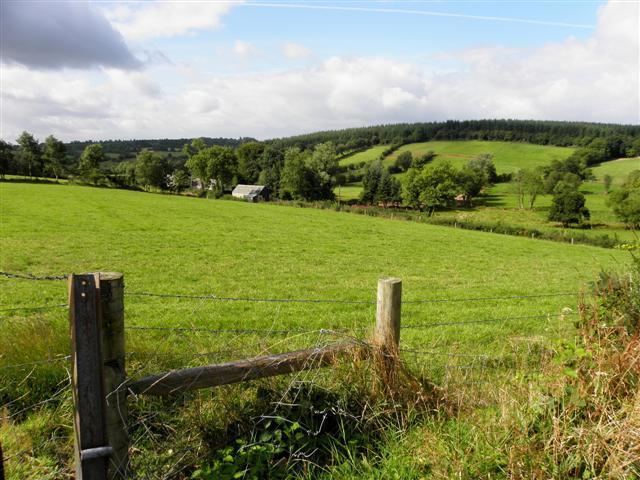Province Ulster | ||
 | ||
Bellaleenan (from Irish: Béal Átha an Líonáin meaning 'The Entrance to the Ford of the Gorge') is a townland in the civil parish of Templeport, County Cavan, Ireland. It lies in the Roman Catholic parish of Templeport and barony of Tullyhaw.
Contents
Map of Bellaleenan, Mountain View, Co. Cavan, Ireland
Geography
Bellaleenan is bounded on the north by Culliagh and Torrewa townlands in Corlough parish, on the west by Drumlaydan townland in Corlough parish, on the south by Sraloaghan, County Leitrim and Ballymagirril townlands and on the east by Stranadarragh and Drumlougher townlands. Its chief geographical features are the River Blackwater, County Cavan, forestry plantations and dug wells.
Bellaleenan is traversed by minor roads and rural lanes.
The townland covers 222 statute acres.
History
The 1609 Baronial Map depicts the townland as part of the four polls of BMcGoagh (Ballemagoechan).
In the Plantation of Ulster by grant dated 13 March 1610, King James VI and I granted four polls of Ballemagoechan to Cahell M'Owen O Reyly. The four polls consisted of 1 in Bealaghlyan, 2 in Acoylagh and 1 in Cronarry, totalling 200 acres. The said Cathal O'Reilly was the nephew of two chiefs of the O'Reilly clan- Aodh Connallach mac Maolmhordha who was chief from 1565–1583 and Eamonn mac Maolmhordha who was chief from 1596–1601. He was also a brother of Cathaoir O'Reilly who received lands in Kildoagh townland and first cousin of Donill Backagh McShane O'Reyly who was simultaneously granted lands in Burren (townland).
An Inquisition of King Charles I of England held in Cavan Town on 31 March 1635 stated that Cahell O Reily was seized in his lifetime of, inter alia, one poll of Bealaghlynan. He died 1 January 1634 and his son Hugh O'Reily had reached his majority and was married.
The O'Reilly lands in Bellaleenan were confiscated in the Cromwellian Act for the Settlement of Ireland 1652 and were distributed as follows-
In the Hearth Money Rolls of 1662 there was one person paying the Hearth Tax in Ballyleenan- Phelemy McKelagher
A grant dated 3 November 1666 was made by King Charles II of England to Sir Tristram Beresford, 1st Baronet which included, inter alia, the lands of Gortnegleigh or Ballymagough. By grant dated 11 September 1670 from King Charles II of England to said Sir Tristram Beresford, the said lands of Gortnegleigh or Ballymagough were included in the creation of a new Manor of Beresford.
Lowther Kirkwood of Mullinagrave, parish of Templeport, Co. Cavan, gentleman made the following will-
2 July 1804. To his grandnephew Lowther Brien, city of Dublin, attorney, and his heirs his lands of Awengallis, Ballylenan, Ballymagirill, Stranadarragh, Carnagimlie, Cullagh, Drumleden, Leitry [Leitra], Corlagh, Lananleragh [Lannanerriagh], Gowlanlea and Drumlogher, Co. Cavan, held under lease from the Beresford family. He had begun a suit in Chancery, Ireland, against John Brien, late of Salvon, Co. Fermanagh, deceased, for setting aside a fradulent deed obtained by said John Brien, which suit against the representatives is to be continued by said Lowther Brien, his sole exor. Witnesses: John Johnston and Andrew Rutledge, both of Ballymagiril, and Thos. Stephenson, Drumleaden, Co. Cavan, gent. Memorial witnessed by: said Andrew Rutledge, and John Balfour, city of Dublin, attorney.
The Tithe Applotment Books for 1827 list eighteen tithepayers in the townland.
Griffith's Valuation of 1857 lists thirteen landholders in the townland.
On 6 July 1857 the Incumbered Estates Commission published the following notice-
In the Matter of the Estate of James Brien, Geo. Brien, Edward Brien and Francis Brien, Owners. Exparte by Isabella Crummer, Petitioner. The commissioners having ordered a Sale of the Lands of Shanadaragh and Curnagunlogh, Cullegh, Drumlohgher, Drumledin, Sananaragh, and Drumledin, and Corlough, situate in the Barony of Tullyhaw, and County of Cavan, held under lease dated the 10th April, 1718, from the Bishop Raphoe, for lives renewable for ever, and which Lands are included in the denominations of Ballymagord, Owngally, Gortneglough, Drumedin or Ballylennin, in said lease mentioned:
In the 1901 census of Ireland, there are ten families listed in the townland, and in the 1911 census of Ireland, there are thirteen families listed in the townland.
Antiquities
The only structure of historical interest in the townland seems to be Saint Patrick's Well, where a pattern was held on the first Sunday in July up to the 1950s, to mark the festival of Lughnasadh.[5]
